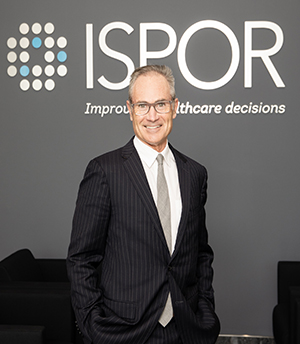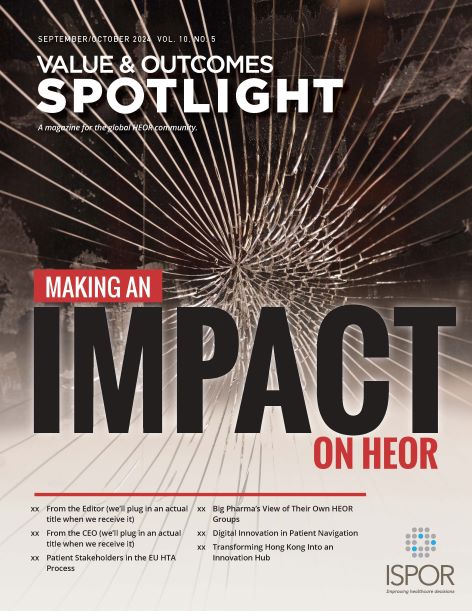Highlighting HEOR Innovation and Impact
Rob Abbott, CEO & Executive Director, ISPOR
 This issue of Value and Outcomes Spotlight comes at an interesting time for health economics and outcomes research (HEOR) professionals. Over the past year, the leaders of several HEOR groups in global biopharmaceutical firms have been let go and the balance of the teams has been dispersed into other functions, typically Market Access or Medical Affairs. Corporate reorganizations are nothing new, but the targeted reorganization of HEOR groups coincides with several important changes within the healthcare landscape. Regulatory expectations for evidence are both increasing and broadening (clinical, economic, patient-centered), the use of artificial intelligence (AI) and digital tools is growing, and there is a push for acceleration in drug development. Meantime, patients are clamoring for accessible, affordable, and effective drugs. Globally, the story is much the same. Populations are aging in many countries and the demand for novel medicines is on the rise. To obtain coverage or reimbursement, companies have to prove that their products both improve on the standard of care and are more cost-effective. Clearing this “4th hurdle,” as it is often called, has never been more important, or difficult, for biopharma. The recent round of layoffs and restructuring of HEOR groups is therefore interesting, to put it politely, because there is some truth to the adage that “there is no access without evidence” and HEOR scientists are the primary generators of that evidence.
This issue of Value and Outcomes Spotlight comes at an interesting time for health economics and outcomes research (HEOR) professionals. Over the past year, the leaders of several HEOR groups in global biopharmaceutical firms have been let go and the balance of the teams has been dispersed into other functions, typically Market Access or Medical Affairs. Corporate reorganizations are nothing new, but the targeted reorganization of HEOR groups coincides with several important changes within the healthcare landscape. Regulatory expectations for evidence are both increasing and broadening (clinical, economic, patient-centered), the use of artificial intelligence (AI) and digital tools is growing, and there is a push for acceleration in drug development. Meantime, patients are clamoring for accessible, affordable, and effective drugs. Globally, the story is much the same. Populations are aging in many countries and the demand for novel medicines is on the rise. To obtain coverage or reimbursement, companies have to prove that their products both improve on the standard of care and are more cost-effective. Clearing this “4th hurdle,” as it is often called, has never been more important, or difficult, for biopharma. The recent round of layoffs and restructuring of HEOR groups is therefore interesting, to put it politely, because there is some truth to the adage that “there is no access without evidence” and HEOR scientists are the primary generators of that evidence.
The way ahead for HEOR needs to be built on the generation of scientifically robust evidence that stands up to the scrutiny of payer organizations—and provides guidance to clinicians, regulators, patient organizations, and other stakeholders.
I therefore welcome the discussions that have been curated for this issue of VOS. I believe that by clearly explaining what HEOR is (and isn’t), where and how it advances drug or product development, and perhaps most importantly, where it can be shown to have influenced healthcare decision making, we honor the men and women who work so hard to generate evidence of real value. As my colleague, Scott Ramsey puts it: value is not about getting something cheap; it’s about bringing the best that medicine has to offer to the largest number of people at reasonable cost. The way ahead for HEOR needs to be built on the generation of scientifically robust evidence that stands up to the scrutiny of payer organizations—and equally, provides guidance to clinicians, regulators, patient organizations, and other stakeholders. HEOR scientists have precisely the skill set needed to do this and demonstrate what represents value and what doesn’t.
How to get started? As a first step, the HEOR profession needs to tell stories of innovation and impact. As an example, in 2007, Pfizer and Bristol-Myers Squibb began development of apixaban as an anticoagulant. The product we know today as Eliquis is used to treat and prevent blood clots and prevent stroke in people with nonvalvular atrial fibrillation. It is on the World Health Organization’s List of Essential Medicines and in 2021 was one of the most commonly prescribed medications in the United States with more than 17 million prescriptions. What is less well known is that Eliquis’ global success revolved around the real-world evidence generation and access strategies that were carefully designed and executed by HEOR scientists. The same is true for antiretroviral therapy for HIV in the United States. The use of 3 or more antiretroviral medicines (1 pill)—commonly called the HIV “cocktail—is currently the standard treatment for HIV infection largely due to the HEOR cost-offset and budget projection work enabling appropriate funding of drug assistance programs at national and state levels. More generally, HEOR has been instrumental in label expansion—demonstrating the clinical and financial efficacy of a product developed for one patient population in another. The common denominator in each of these examples is the pivotal role that HEOR played in bringing a product to market.
Ultimately there is no single (or simple) algorithm that fosters better healthcare decisions, but I’m convinced that the multidisciplinary science that is HEOR offers the best chance to move the needle forward.
ISPOR has recently launched a bold new strategy anchored by a vision of “a world in which healthcare is accessible, effective, efficient, and affordable for all.”1 We will realize this vision by leveraging HEOR to improve evidence-generation methods and the speed with which they are deployed; by converting health data from sources like wearables and electronic health records into useful evidence that can shape healthcare decisions; and by reaching out to our industry and other partners to better understand their pain points and where HEOR can address them. The scientific disciplines that underpin HEOR offer tremendous power, rigor, and credibility to C-suite executives, especially now, if they increase their fluency in it. Among other benefits, HEOR, when done strategically and in the context of a company’s broad business objectives, can pull the right data together to reduce uncertainty. ISPOR will be the primary catalyst in the development and communication of HEOR evidence to support this work—it benefits all of us with an interest in improving healthcare.
Moving forward, HEOR needs to be recast not as an academic or purely scientific exercise exclusively, but rather as a multidisciplinary body of work that can be a key agent of innovation in healthcare. The stories of innovation and impact gathered here do a wonderful job of illustrating how this is being done today and how HEOR can grow its impact tomorrow. I’m especially excited by the ways in which HEOR is incorporating AI capabilities through generative AI and large language models to enhance real-world data analyses, model programming, and literature reviews. Ultimately there is no single (or simple) algorithm that fosters better healthcare decisions, but I’m convinced that the multidisciplinary science that is HEOR offers the best chance to move the needle forward.

